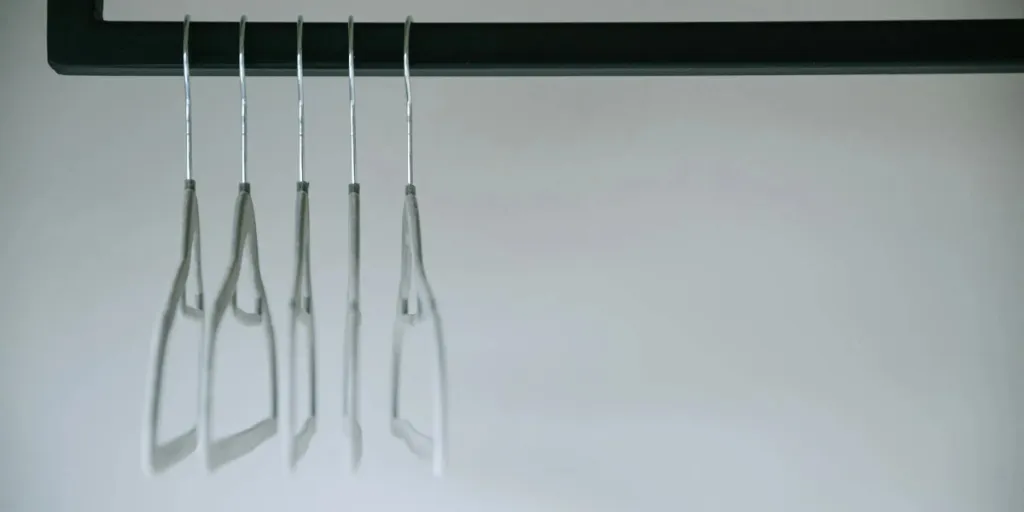Clothes hangers are an everyday item that helps people and businesses store clothes. Selecting the right hangers impacts the durability and shape of the clothes. In addition, hangers determine the amount of air circulating around clothing and eliminate wrinkles, thereby offering protection as well.
Demand for hangers has significantly increased in recent years due to the growth of the fashion industry. People are buying more clothes than before due to the rise of fast fashion and the desire to explore new styles. As a result, the global fashion industry is projected to generate US$ 670.90 billion in 2024 and grow at a compound annual growth rate (CAGR) of 9.02% to reach US$ 1.033 billion in 2029. This growth translates into demand for clothes hangers as people need ways to store and organize their clothing.
This blog provides an overview of the global market for hangers and offers our top tips for selecting the best hangers for different end customers in 2024.
Table of Contents
Clothes hangers market overview
Types of clothes hangers
Factors to consider when selecting clothes hangers
Final thoughts
Clothes hangers market overview

The global clothes hangers market has experienced substantial growth in recent years. Future Market Insights projects that the hangers’ market value will reach US$ 1,043.6 million in 2032, recording an 8% annual growth rate between 2022-2032. The report also identifies North America as the largest market for clothes hangers, with a 24% market share, followed by Europe with 19%. The primary key players in this industry include M&B Hangers, Guilin Iango Home Collection, MAWA, Weatherford, Mainetti, and Whitmor.
The various factors driving the market growth for clothes hangers worldwide include:
- Substantial growth in the commercial use of clothes hangers, especially in the retail and hospitality sectors
- E-commerce growth, which has enhanced people’s access to a variety of hangers and clothes
- Increased population growth and urbanization have led to a higher demand for clothes hangers in the residential sector
- Increased consumer awareness of environmental and sustainability issues, which has led to growing demand for eco-friendly hangers
- The emergence of intelligence hangers or electric clothes hangers, which provide an efficient way of drying clothes in all seasons
Types of clothes hangers

There are various types of clothes hangers, often classified based on materials, designs, and intended use. Here is an overview of the main types to consider when stocking your inventory:
Wooden hangers
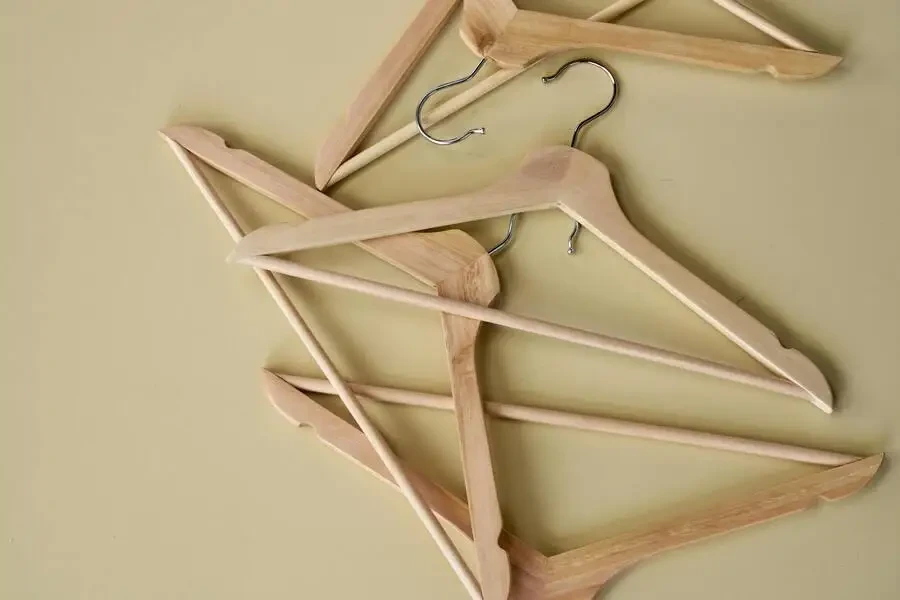
Wooden clothes hangers are considered the best hangers due to their longevity and durability. They can be used to hang heavy clothes, such as jackets and suits, without bending or breaking. In addition, wooden hangers prevent clothes from wrinkling, tearing, and sagging.
They come in varying shapes, designs, and sizes, thereby providing options that meet garment-specific needs. For example, pants’ wooden hangers come with a velvet-covered bar that ensures pants stay wrinkle-free. In addition, wooden hangers have a secure grip that ensures clothes don’t slip off.
However, they are more expensive than other types of hangers, such as plastic and wire hangers. They also take up more space.
Plastic hangers
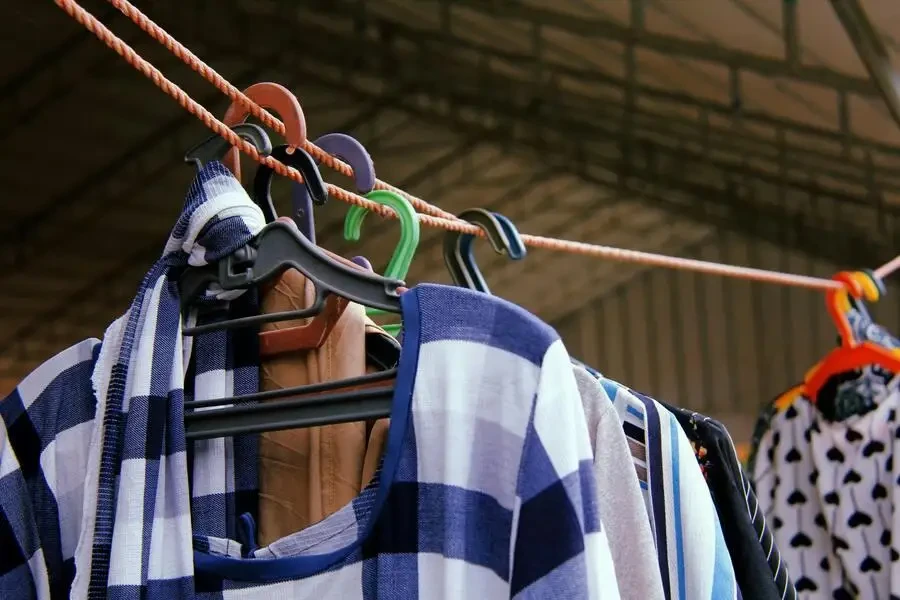
Plastic hangers are popular among customers due to their cost-effectiveness. They are also easy to find and suitable for lightweight clothes such as shirts, blouses, and light dresses. Plastic hangers also come in a range of colors, sizes, and shapes, allowing consumers to choose options that best suit their needs and preferences.
Plastic clothes hangers are appropriate for hanging kids’ clothes. Children quickly outgrow their clothes, making plastic hangers a cost-effective option. They have a low risk of damage since children’s clothes are not hung for long.
However, plastic hangers have a significant environmental impact since they are often made from non-biodegradable materials, such as polypropylene or polystyrene. A report found that approximately 128 billion plastic hangers are used annually worldwide, and the majority end up in landfills.
Plastic clothes hangers also lack aesthetic appeal and are unsuitable for heavy garments.
Wire hangers
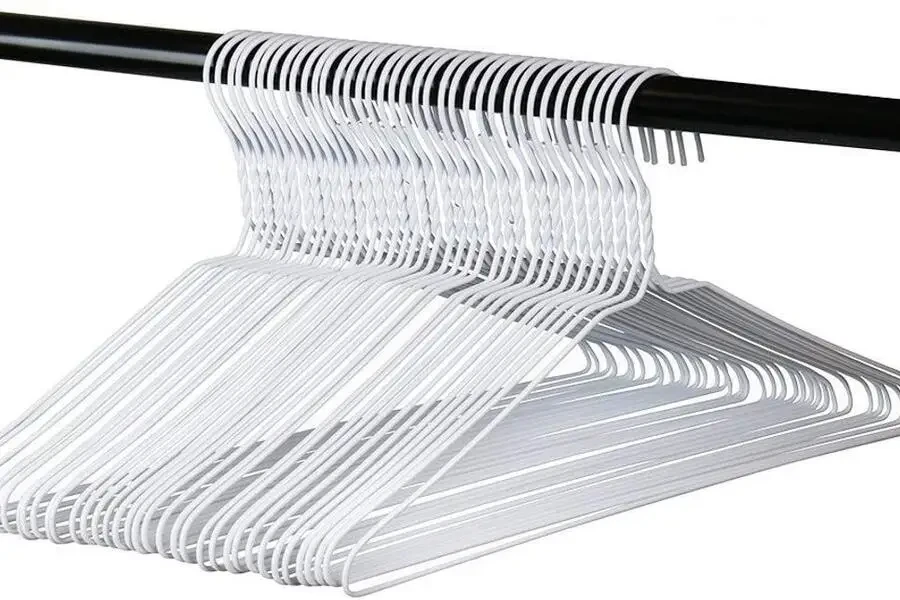
Wire hangers are typically made from metals, with steel and aluminum as the most common materials. These metals offer durability, strength, and flexibility, making them suitable for supporting various types of garments. In addition, the wire hangers are usually thin and adaptable, allowing users to bend or shape them to accommodate different clothes sizes and shapes.
While they are suitable for lightweight clothes, the easy bending makes them unsuitable for heavy garments. In addition, wires can rust, thereby staining clothes.
However, there are more durable and high-quality wire hangers. Although they are often more expensive, these wire hangers are aesthetically appealing and can handle heavy clothes, such as jackets and coats.
Velvet hangers
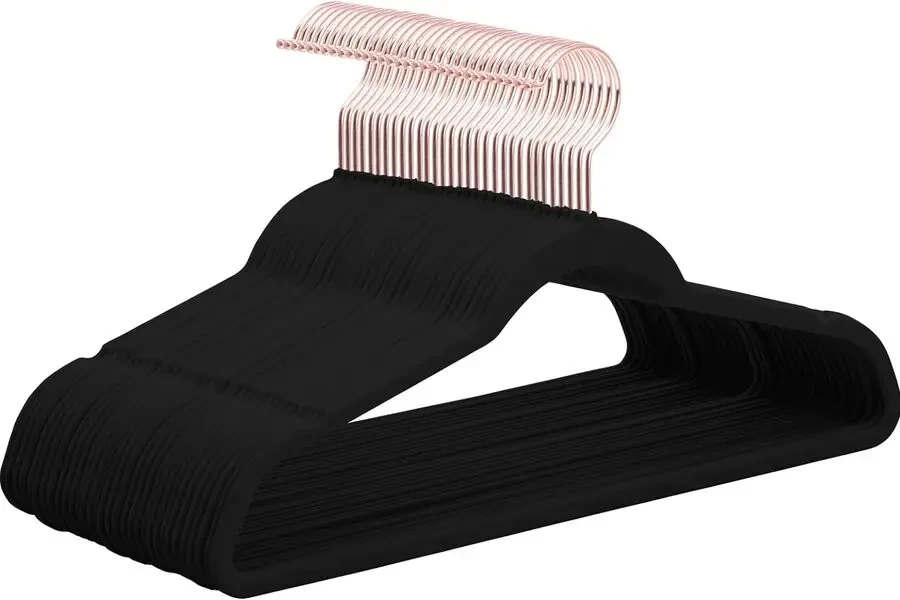
Velvet clothes hangers are suitable for delicate garments, like lingerie, scarves, and ties, as well as fabrics like silk, satin, or chiffon. They have a soft velvet covering that gently grips clothing to prevent slipping, ripping, or stretching, thereby maintaining the clothes’ shape.
However, velvet hangers may require frequent cleaning since the velvet material may attract and hold onto lint, dust, and pet hair. In addition, the velvet covering wears down over time or becomes damaged, making them less durable compared to other hangers like wooden.
Coat hangers
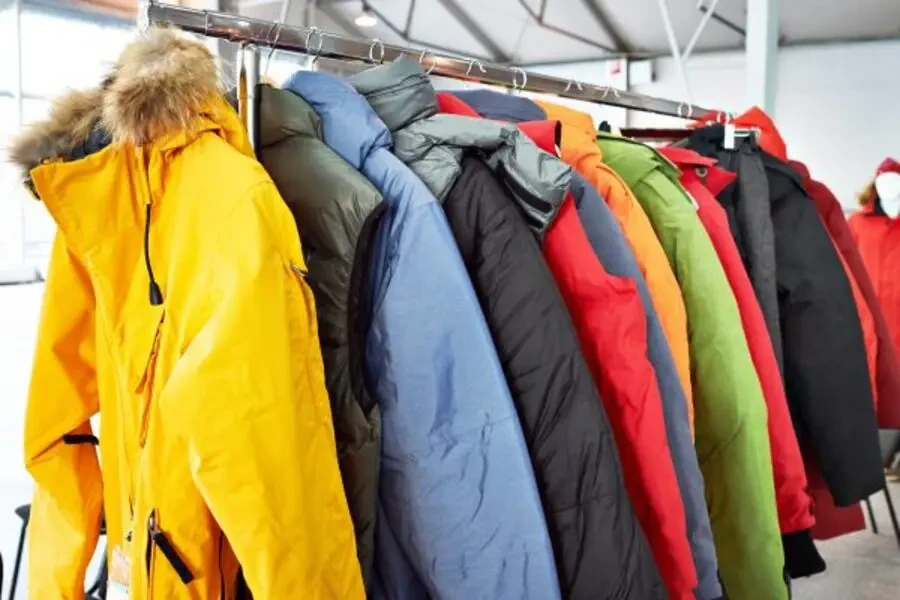
Coat hangers are specifically designed to support and maintain the shape of heavy outerwear garments like coats, jackets, and suits. They are often made from sturdy materials such as wood or metal to provide sufficient support for heavier items.
Coat hangers often have broader shoulder areas to help preserve the shape of the garment’s shoulders and prevent them from becoming distorted or stretched out. Some have additional features, such as trouser bars or clips to accommodate coordinating pants or skirts.
Pants hangers
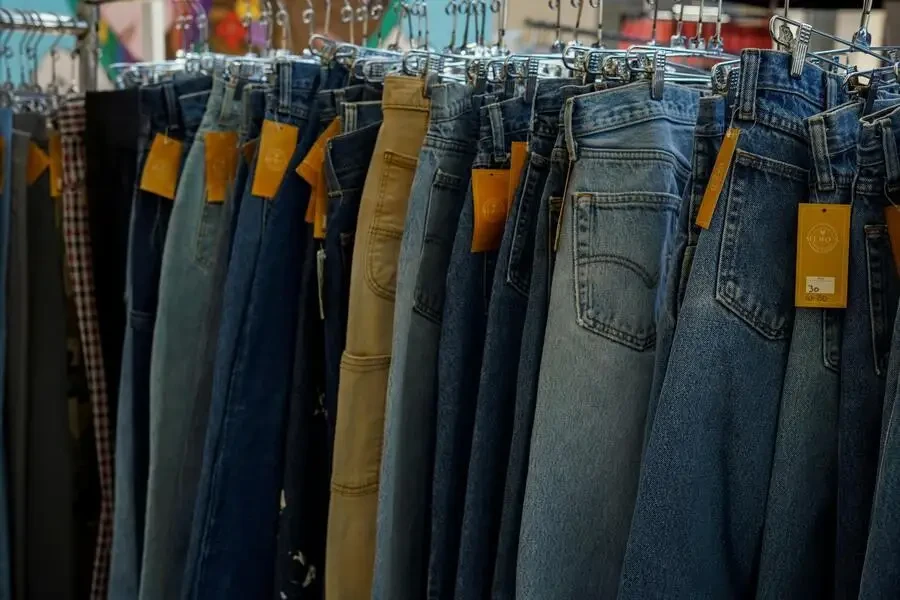
Pants hangers are used to organize and store pants, trousers, and other bottom-wear garments. They have adjustable clips or bars that securely hold the waistband or hem of the garment in place. These features prevent wrinkles and maintain the garment’s shape.
Some pants hangers have non-slip grips or padding that prevent the pants from sliding off or becoming creased.
Factors to consider when selecting clothes hangers
Customers have varying needs and preferences that determine their demand for clothes hangers. As a result, their decision-making is influenced by different factors, including:
Material
The material used to make clothes hangers can directly impact their longevity, functionality, and appearance. For instance, plastic hangers are known for their lightweight nature and affordability, making them ideal for everyday use in residential settings. On the other hand, wooden hangers have an elegant aesthetic appeal and are more durable, making them suitable for heavier clothes like suits and coats.
Businesses should stock clothes hangers made of different materials to cater to varying customer needs.
Intended use
Most customers choose clothes hangers based on the type of clothes they intend to hang. For instance, velvet hangers can appeal to clients looking to hang delicate garments such as baby clothes, formal wear, and luxurious fabrics. Others may prioritize hangers designed for specific garments, such as coat hangers or pants and skirt hangers.
Customers with limited space may opt for sleek, space-saving designs. Those buying clothes hangers for commercial use may prioritize durable and functional hangers that can withstand the rigors of high-volume retail environments.
Profiling the ideal customers and understanding their intended use for hangers helps ensure that the stocked hangers meet their specific needs.
Hanger features
Hangers with additional features have enhanced functionality and can accommodate diverse wardrobe needs. For example, adjustable clips or bars on pants hangers offer versatility by accommodating various waistband sizes and trouser lengths. Padded hangers provide a cushioned surface that protects delicate fabrics and prevents creases.
Consumers living in humid areas may benefit from moisture- and insect-repellent hangers. These hangers are made from cedar wood and can repel insects such as moths and absorb moisture.
Other features to consider are multilayer and cascading hangers. These hangers allow users to hang additional items.
Sizes
Customers often compare hanger sizes to the dimensions of the clothes they intend to hang. Appropriately sized hangers provide the necessary support to maintain the garments’ shape and appearance.
For instance, small hangers can distort or stretch the garment, thereby compromising its structural integrity and appearance. Similarly, oversized hangers can cause the clothes to sag while also occupying unnecessary space. These adverse outcomes make hanger size a crucial consideration.
Hangers for accessories
Accessories such as scarves, belts, and ties require dedicated storage solutions to keep them tidy and easily accessible. Some specialty hangers are designed with features such as hooks, loops, and compartments that meet the unique requirements of each accessory.
Belt hangers may have hooks or slots to help organize belts neatly and within reach. Scarf hangers, on the other hand, may have multiple loops to help display the users’ scarves collection.
Final thoughts
The global clothes hangers market is experiencing substantial growth due to the explosive growth in the fashion and e-commerce industries. In addition, hanger use in both residential and commercial sectors is driving significant growth. This demand creates opportunities for businesses that sell hangers, which can be leveraged to boost financial performance and competitiveness.
As a result, businesses should stock various types of clothes hangers, from wood to plastic, wire, velvet, coat, and pants hangers. This diversity helps cater to a wide clientele. However, it is crucial to consider factors such as material, hanger features, intended use, sizes, and accessory hangers when selecting the best options for different end customers. These considerations help ensure that the stocked clothes hangers meet the target customers’ specific needs and preferences. Visit Alibaba.com for a wide selection of clothes hangers at competitive prices.
